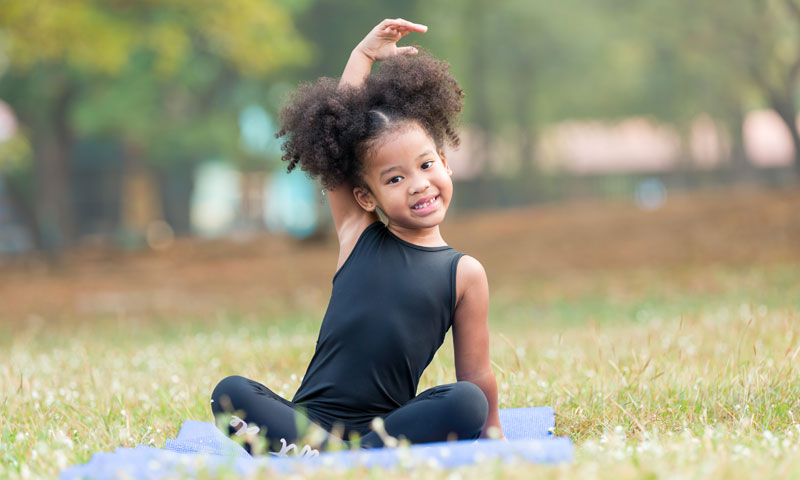Whether from busy schedules, pressures of work, or news and current events, it can be common for parents to feel stressed. However, it's important to remember that stress is not limited to adults – children and teens can experience stress, too.
"Children can experience stress or anxiety for a variety of reasons, such as changes in routine, interpersonal conflict or from expectations placed upon them," says Mayuri Patel Garg, MPH, Program Manager of the Weight Management Program at Children's Health℠. "Children can also take on stress from their surroundings."
Children experience stress differently than adults, and they don't always have the words to express their feelings. This means that stress can show up in a variety of ways – such as mood swings, acting out, poor sleep or concentration, and even complaints of stomach aches or headaches.
Stress and anxiety can also lead to unhealthy habits, such as overeating or substance use. "Teaching your child healthy ways to handle their emotions from a young age can provide them with skills they will need as they get older," Patel Garg says.
Regular physical activity is one way to relieve stress and positively affect mental health. Learn why and see ideas for stress-reducing activities to incorporate into your family's routine.
How does exercise reduce stress?
Whether you're a kid or an adult, physical activity can be a healthy and effective way to cope with stress and anxiety.
"Physical activity reduces the level of stress hormones in the body and increases chemicals in the brain that boost our mood and reduce pain," Patel Garg explains. "It has been shown to reduce symptoms of depression and anxiety while improving well-being and quality of life."
Regular physical activity and exercise can also:
- Build confidence and self-esteem
- Improve focus and concentration
- Improve quality of sleep
- Provide social interaction, support and bonding
Any kind of exercise is likely to reduce stress levels, so find what works best for you and your family.
5 stress relief activities for kids
1. Aerobic activity
Aerobic activity is one of the best ways to reduce stress – it can get the blood pumping, which releases chemicals that improve your mood. Try one of these family-friendly exercises:
- Bike or scooter rides
- Family walks or hikes
- Hula hooping
- Jump roping
- Swimming
If you have a packed schedule, don't worry about setting aside large chunks of time for an aerobic workout. Children need at least 60 minutes of physical activity each day, but you can break this time up into short periods.
Patel Garg also recommends trying to fit in small bursts of activity during periods of downtime. For example, you can try a few jumping jacks or frog hops during TV commercial breaks. Download these exercise cards for more ideas to get moving.
2. Stretching
Stretching can help you recognize and relieve tension in muscles. You can teach your child to stop and do a quick stretch if they start to feel stress throughout the day. Stretching can also be beneficial before bed because it allows children to wind down and get ready for sleep. Here are some stress-relieving stretches you can try together:
- Reach for the sky – Stand with your feet hip-width apart, raise your arms above your head and reach up.
- Toe touches – Keep your back as straight as possible, bend at your waist and reach for your toes.
- V-sit – Sit on the floor with your legs out to each side, reach for your toes on one side, repeat on the other side, then reach down the middle. Keep your back as straight as possible and hold each position for 15-30 seconds.
- Butterfly – Sit on the floor and touch the bottom of your feet together, then flap your knees like a butterfly.
- Neck stretch – Tilt your head to one side, letting your ear fall as close to your shoulder as you can without pushing your head down. Repeat on the other side.
- Wrist stretch – Hold your arm in front of you with your palm facing forward (in a "stop" position). Then, use your other hand to gently pull your fingertips back until you feel a slight stretch in your wrist. Then, flip your palm down so it's facing you and gently pull your fingertips down to stretch the back of the wrist. Repeat on the other side.
3. Yoga
Yoga is part exercise, part meditation, which is perfect for clearing the mind and easing stress. Like stretching, yoga can also be helpful before bed to help your child relax. It can also be a helpful way to start the day with a calm mind.
Here is a sequence of yoga poses for stress relief you can try with your kids. Complete each move slowly, one after the other to create a yoga "flow."
- Swan dive – Stand with your legs hip-width apart. Reach both arms out to your sides and up to the sky, holding for a breath. At the same time, slowly lower your arms and bend at the waist, keeping your back straight. Reach for the ground.
- Downward dog – From the swan dive, place your hands on the ground and walk your feet back until your body is in an ‘A' shape. Look between your hands.
- Cobra – From downward dog, lower your body down until you're flat on your stomach. Place your palms shoulder-width apart and push your chest up until you're arching your back and you feel a stretch in your stomach muscles.
- Child's pose – From cobra, lower yourself back down to your stomach. Push yourself up to your hands and knees with your knees hip-width apart. Touch your big toes together and lower your bottom down to your heels. Lower your stomach between your knees, place your forehead on the ground or your hand and reach your hands forward as far as you can. Rest in this position as long as you'd like and repeat the sequence if desired.
4. Deep breathing and guided imagery
Deep breathing is a great way to bring down your heart rate and focus when you're feeling overwhelmed. There are plenty of apps, books and YouTube videos that offer guidance on breathing techniques. Patel Garg also recommends creating imagery along with breathing techniques to help keep kids engaged.
"Teach your child how to take slow, deep breaths by practicing smelling a flower through their nose," she says. "Then, encourage them to breathe out slowly by imagining they're blowing a bubble."
Children can also envision throwing away their negative feelings by pretending to crumple up a piece of paper and throwing it as far as possible. That piece of paper represents all their worries and stress, and it shows that they can let go of their negative feelings.
5. Get outside
We're all guilty of spending too much time with screens, children and adults alike. Too much screen time can be overstimulating, especially for kids, which can cause more stress and anxiety.
"Children may use screen time to self-soothe, which continues the cycle of being overstimulated," says Patel Garg. "The brain needs a break to process and reflect, but today's digitally connected culture is not conducive to that need."
Instead of spending another hour watching television or checking social media, Patel Garg recommends getting outside as much as possible. Being in nature has shown to improve mood and feelings of well-being. Explore a new park or hiking trail or create a scavenger hunt in your backyard. Or simply take a walk around the neighborhood together and take the time to connect.
Recognize stress and model healthy ways to cope
As parents, it's important to keep in mind that kids may not always recognize when they're feeling stressed or anxious. Teach them how to recognize these feelings and show them that there are healthy ways to cope.
"Help your child identify their feelings by making non-judgmental observations of how you perceive they're feeling," Patel Garg says. "Then, listen without judgment and repeat what they're saying in your own words to make sure you understand completely."
For example, ask your child how they're feeling after their school day. Then, you might reply with, "It sounds like you're feeling nervous about your new school schedule. Is that right?"
Assure your child that their feelings are valid. You can also model healthy coping skills by sharing things you do to make you feel better when you are nervous.
If you find your child is increasingly stressed, anxious or overwhelmed, don't hesitate to reach out to your pediatrician or a mental health expert. They can offer added support and guidance. Learn more about mental health services at Children's Health.
Learn more
Get Up & Go offers a wide range of programs and services to empower families in making lasting healthy lifestyle changes. Learn more about our programs to support healthy and active lives, or view more tips for stress management.

Thank you!
You are now subscribed to the Children's Health Family Newsletter.
Children's Health will not sell, share or rent your information to third parties. Please read our privacy policy.
